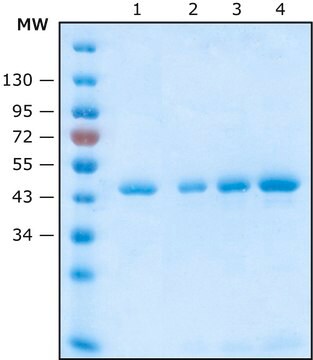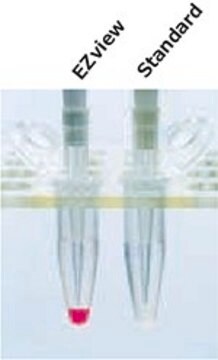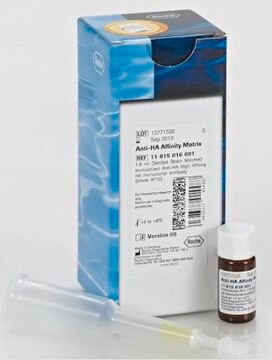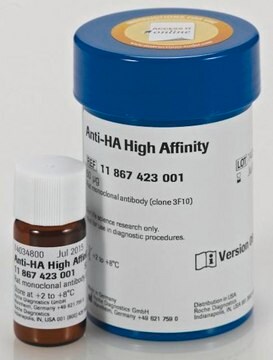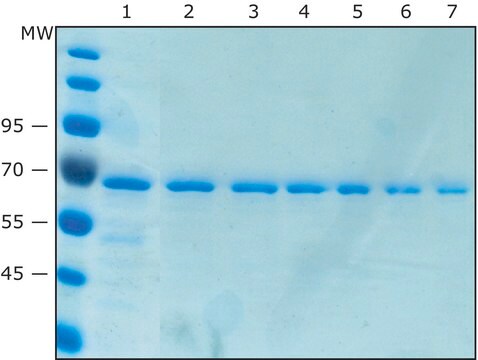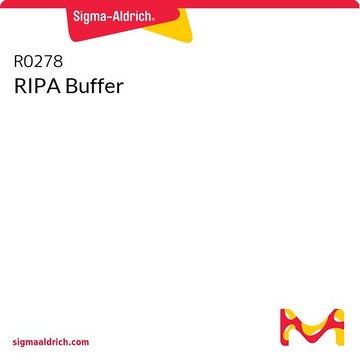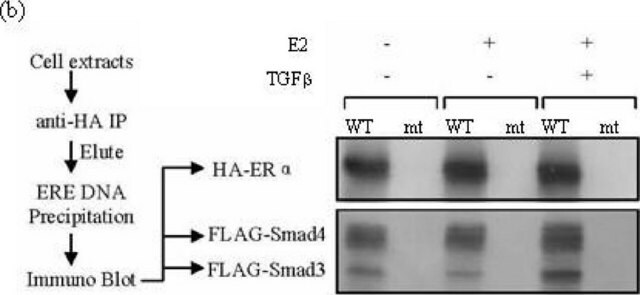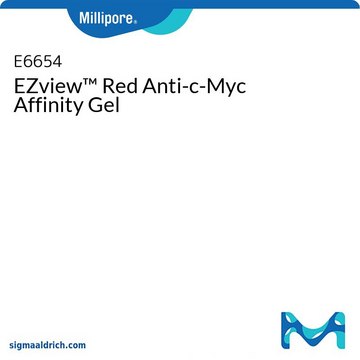IP0010
Anti-HA Immunoprecipitation Kit
Autenticatiper visualizzare i prezzi riservati alla tua organizzazione & contrattuali
About This Item
Codice UNSPSC:
12352203
NACRES:
NA.56
Prodotti consigliati
Tipo di anticorpo
primary antibodies
Clone
monoclonal
Classi chimiche degli analiti
proteins (hemagglutinin)
tecniche
immunoprecipitation (IP): suitable
Temperatura di conservazione
2-8°C
Descrizione generale
Anti-hemagglutinin (HA) Immunoprecipitation Kit is designed to recover maximum amounts of HA-tagged proteins in the immunoprecipitates. The process is carried out in mini-spin columns instead of microcentrifuge tubes to ensure easy washing of antigen-antibody-bound beads with minimal variability.
Applicazioni
Anti- hemagglutinin (HA) Immunoprecipitation Kit has been used for immunoprecipitation. It has also been used in in vitro acetylation assay from human embryonic kidney cell lines.
Caratteristiche e vantaggi
- Anti- hemagglutinin (HA) coupled beads enable high specific binding to HA-tagged fusion proteins
- Coupling of Anti-HA antibodies to the beads eliminates other preliminary and calibration steps
- Mini-spin columns enable the minimal loss of anti-HA-bound beads during washing
- The CelLyticTM M cell lysis reagent provides a high yield, rapid and efficient mammalian cell lysis
- Ready-to-use cell lysis reagent and 10X concentrated immunoprecipitation buffer
Non trovi il prodotto giusto?
Prova il nostro Motore di ricerca dei prodotti.
I componenti del kit sono disponibili anche separatamente
N° Catalogo
Descrizione
SDS
Codice della classe di stoccaggio
10 - Combustible liquids
Classe di pericolosità dell'acqua (WGK)
WGK 3
Punto d’infiammabilità (°F)
Not applicable
Punto d’infiammabilità (°C)
Not applicable
Scegli una delle versioni più recenti:
Possiedi già questo prodotto?
I documenti relativi ai prodotti acquistati recentemente sono disponibili nell’Archivio dei documenti.
I clienti hanno visto anche
Podocyte-Specific Overexpression of Wild Type or Mutant Trpc6 in Mice Is Sufficient to Cause Glomerular Disease
Krall,P et al.
PLoS ONE, 5(9) (2010)
Paola Krall et al.
PloS one, 5(9), e12859-e12859 (2010-09-30)
Mutations in the TRPC6 calcium channel (Transient receptor potential channel 6) gene have been associated with familiar forms of Focal and Segmental Glomerulosclerosis (FSGS) affecting children and adults. In addition, acquired glomerular diseases are associated with increased expression levels of
Lin Jin et al.
PLoS pathogens, 12(5), e1005609-e1005609 (2016-05-19)
Bacterial AvrE-family Type-III effector proteins (T3Es) contribute significantly to the virulence of plant-pathogenic species of Pseudomonas, Pantoea, Ralstonia, Erwinia, Dickeya and Pectobacterium, with hosts ranging from monocots to dicots. However, the mode of action of AvrE-family T3Es remains enigmatic, due
Xiaolong Tang et al.
Nature communications, 12(1), 5058-5058 (2021-08-27)
Dietary interventions such as intermittent fasting (IF) have emerged as an attractive strategy for cancer therapies; therefore, understanding the underlying molecular mechanisms is pivotal. Here, we find SIRT7 decline markedly attenuates the anti-tumor effect of IF. Mechanistically, AMP-activated protein kinase
Satadru K Lahiri et al.
American journal of cancer research, 6(5), 910-923 (2016-06-14)
Krüppel-like factor 8 (KLF8) plays important roles in cancer and is strictly regulated by various post-translational modifications such as sumoylation, acetylation, ubiquitylation and PARylation. Here we report a novel phosphorylation of KLF8 by ERK2 responsible and critical for the stability
Il team dei nostri ricercatori vanta grande esperienza in tutte le aree della ricerca quali Life Science, scienza dei materiali, sintesi chimica, cromatografia, discipline analitiche, ecc..
Contatta l'Assistenza Tecnica.